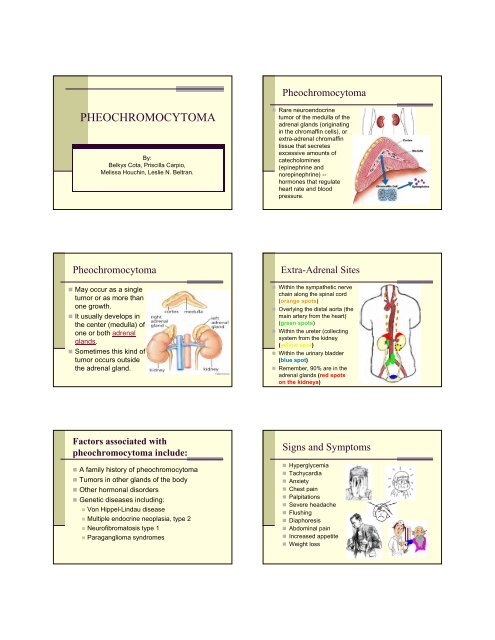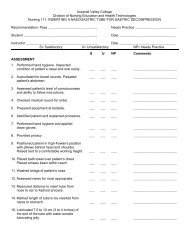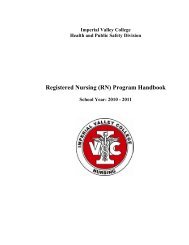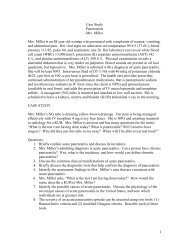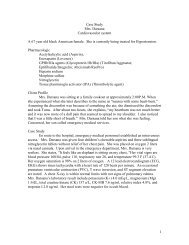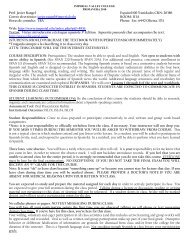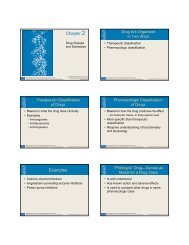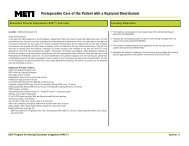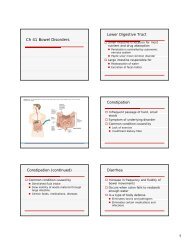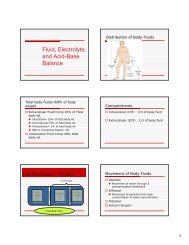PHEOCHROMOCYTOMA
PHEOCHROMOCYTOMA
PHEOCHROMOCYTOMA
You also want an ePaper? Increase the reach of your titles
YUMPU automatically turns print PDFs into web optimized ePapers that Google loves.
Pheochromocytoma<br />
<strong>PHEOCHROMOCYTOMA</strong><br />
By:<br />
Belkys Cota, Priscilla Carpio,<br />
Melissa Houchin, Leslie N. Beltran.<br />
• Rare neuroendocrine<br />
tumor of the medulla of the<br />
adrenal glands (originating<br />
in the chromaffin cells), or<br />
extra-adrenal chromaffin<br />
tissue that secretes<br />
excessive amounts of<br />
catecholomines<br />
(epinephrine and<br />
norepinephrine) --<br />
hormones that regulate<br />
heart rate and blood<br />
pressure.<br />
Pheochromocytoma<br />
• May occur as a single<br />
tumor or as more than<br />
one growth.<br />
• It usually develops in<br />
the center (medulla) of<br />
one or both adrenal<br />
glands.<br />
• Sometimes this kind of<br />
tumor occurs outside<br />
the adrenal gland.<br />
Extra-Adrenal Sites<br />
• Within the sympathetic nerve<br />
chain along the spinal cord<br />
(orange spots)<br />
• Overlying the distal aorta (the<br />
main artery from the heart)<br />
(green spots)<br />
• Within the ureter (collecting<br />
system from the kidney<br />
(yellow spot)<br />
• Within the urinary bladder<br />
(blue spot)<br />
• Remember, 90% are in the<br />
adrenal glands (red spots<br />
on the kidneys)<br />
Factors associated with<br />
pheochromocytoma include:<br />
• A family history of pheochromocytoma<br />
• Tumors in other glands of the body<br />
• Other hormonal disorders<br />
• Genetic diseases including:<br />
• Von Hippel-Lindau disease<br />
• Multiple endocrine neoplasia, type 2<br />
• Neurofibromatosis type 1<br />
• Paraganglioma syndromes<br />
Signs and Symptoms<br />
• Hyperglycemia<br />
• Tachycardia<br />
• Anxiety<br />
• Chest pain<br />
• Palpitations<br />
• Severe headache<br />
• Flushing<br />
• Diaphoresis<br />
• Abdominal pain<br />
• Increased appetite<br />
• Weight loss
Exams and Tests:<br />
• 24 hr Urine Sample<br />
• Plasma levels of<br />
Catecholamines<br />
• Glucose test<br />
• Adrenal biopsy<br />
• Abdominal CT scan<br />
• MRI of abdomen<br />
• ultrasonography<br />
Laboratory analysis will<br />
reveal increased urine<br />
catecholamines,<br />
vanillylmandelic acid<br />
(VMA) and<br />
metanephrine.<br />
Treatment<br />
Pharmacologic Therapy<br />
Decrease BP:<br />
•Alpha-adrenergic blocking agents.-<br />
eg. Phentolamine (Regitine)<br />
•Smooth muscle relaxants.-<br />
eg. Na nitroprusside (Nipride)<br />
Before and During Surgery:<br />
• Long-acting alphablocker.-<br />
Phenoxybenzamine (Dibenzyline)<br />
• Ca Channel Blockers.-<br />
Nifedipine (Procardia)<br />
•Beta-adrenergic blocking agents.-<br />
Propranolol (Inderal)<br />
•Cathecholamine synths. inhibitors.-<br />
Methyrosine<br />
Surgical Management<br />
•Adrenalectomy<br />
•Nipride<br />
•IV Corticosteroid replacement:<br />
Solu-Medrol<br />
•Oral Corticosteroids:<br />
Prednisone<br />
Prognosis<br />
Assessment Findings<br />
•1/3 Patients continue to be hypertensive:<br />
1)Not all tissue removed<br />
2)Recurrence<br />
3)Blood vessels damaged by severe & prolonged<br />
hypertension<br />
•The tumors come back in less than 10% of these<br />
patients.<br />
• Release of the hormones norepinephrine and<br />
epinephrine returns to normal after surgery.<br />
•Less than 50% of patients who have cancerous<br />
tumors that spread to the bones, liver, or lung are<br />
alive after 5 years.<br />
• hypertension (may be persistent, fluctuating,<br />
intermittent, or paroxysmal)<br />
• pounding headaches<br />
• hyperglycemia and glucosuria<br />
• tachycardia, apprehension, palpitations<br />
• profuse sweating, cold extremities<br />
• nausea, vomiting<br />
• dilated pupils<br />
Nursing Assessment:<br />
Nursing assessment cont…<br />
• The “Five Hs”<br />
- Hypertension<br />
- Headache<br />
- Hyperhidrosis<br />
- Hypermetabolism<br />
- Hyperglycemia<br />
Presence of these signs<br />
has a 93.8% specificity<br />
& 90.9% sensitivity for<br />
pheochromocytoma.<br />
• Blood sugar<br />
- Hypoglycemia (after surgery)<br />
- Hyperglycemia (before and during surgery)<br />
• Blood pressure<br />
- Hypertension (before and during surgery)<br />
- Hypotension (after surgery)
Nursing assessment cont…<br />
• Other vital signs<br />
• hemodynamic parameters<br />
• fluid and electrolyte status—including intake<br />
and urinary output—and urine catecholamine<br />
levels.<br />
• Assess the patient for bleeding and infection<br />
• Assess the patient for pain<br />
Nursing Dx:<br />
• Risk for injury related to potential for<br />
hypertensive crisis.<br />
Patient Outcomes:<br />
• Identify early sign and symptoms of<br />
hypertensive crisis, and seek medical<br />
treatment immediately if they develop<br />
• Avoid factor known to precipitated<br />
hypertensive crisis<br />
• Remain free for injury<br />
Nursing Dx:<br />
• Anxiety related to potential seriousness and<br />
associated complications of<br />
pheochromocytoma.<br />
Nursing Dx:<br />
• Ineffective renal tissue perfusion related to<br />
adverse effects of hypertension in renal<br />
vascular system.<br />
Patient Outcomes:<br />
• Identify and express her/his feelings about<br />
the diagnosis<br />
• Perform activities that help lower anxiety<br />
• Demonstrate positive coping method<br />
Patient Outcomes:<br />
• Maintain adequate renal function<br />
• Have normal renal function studies<br />
Planning & Implementation<br />
Evaluation:<br />
• Stabilize patient :<br />
1) Prescribed Bedrest<br />
2) Pharmacologic Treatment<br />
• Patient teaching:<br />
Treatment<br />
Prognosis<br />
• Prepare patient for treatment<br />
• Monitor: ECG changes, arterial pressures, fluid and<br />
electrolyte balance, and blood glucose levels.<br />
• Patient teaching: Self-Care, Follow-up visits.<br />
• BP stable<br />
• Hyperglycemia controlled<br />
• Patient reports pain relief and improves<br />
comfort<br />
• Lungs are clear to auscultation<br />
• No signs of resp. problems<br />
• There is no evidence of infection<br />
• Follow- Up
Question #1<br />
• 90% of all pheochromocytomas are found?<br />
a) Within the sympathetic nerve chain along the<br />
spinal cord<br />
b) In the medulla of the adrenal glands<br />
c) Within the urinary bladder<br />
d) All of the above<br />
Question #2<br />
Question #3<br />
• Pheochromocytoma disturbs the secretion of<br />
which hormones?<br />
• Which is the most common symptom related<br />
to pheochromocytoma?<br />
1) TSH<br />
2) FSH<br />
3) Epinephrine & Norepinephrine<br />
4) ACTH<br />
1) Pyuresis<br />
2) Nausea & Vomiting<br />
3) Anxiety<br />
4) Hypertension<br />
Question #4<br />
• What is the most conclusive test for the<br />
diagnosis of pheochromocytoma?<br />
1) CT scan<br />
2) MRI<br />
3) 24 hr Urine Sample<br />
4) Ultrasonography<br />
Question #5<br />
• What is the primary treatment for this tumor?<br />
1) Adrenalectomy<br />
2) Chemotherapy<br />
3) Insulin Therapy<br />
4) Radiation
References<br />
Clayton L. Thomas, MD, MPH. Taber’s Cyclopedic Medical Dictionary, Edition 16<br />
Illustrated. F.A. Davis Company, Philadelphia, 2005.<br />
Dalal, T., Maher, M. (2005) Extraadrenal Pheochromocytoma: A Rare Cause of<br />
Tachycardia and Hypertension During Percutaneous Biopsy . Massachusetts General<br />
Hospital and Harvard Medical School Boston, MA 02114.<br />
http://www.ajronline.org/cgi/content/full/185/2/554?ck=nck<br />
Gavaghan, M. (1997) Surgical treatment of pheochromocytomas AORNJournal.<br />
http://findarticles.com/p/articles/mi_m0FSL/is_<br />
n6_v65/ai_19532261<br />
Pheochromocytoma Prognosis. Retrieved March 6, 2008, from eMedTV (2008):<br />
http://cancer.emedtv.com/pheochromocytoma/pheochromocytoma-prognosis.html<br />
Pheochromocytoma. Retrieved March 6, 2008, from Wikipedia (2008):<br />
http://en.wikipedia.org/wiki/Pheochromocytoma<br />
Smeltzer, S.C., Bare, G.B., Hinkle, J.L. (2008). Brunner & Suddarth’s: Textbook of<br />
Medical-Surgical Nursing (11 th ed.). Philadelphia: Lippincott Williams & Wilkins.


